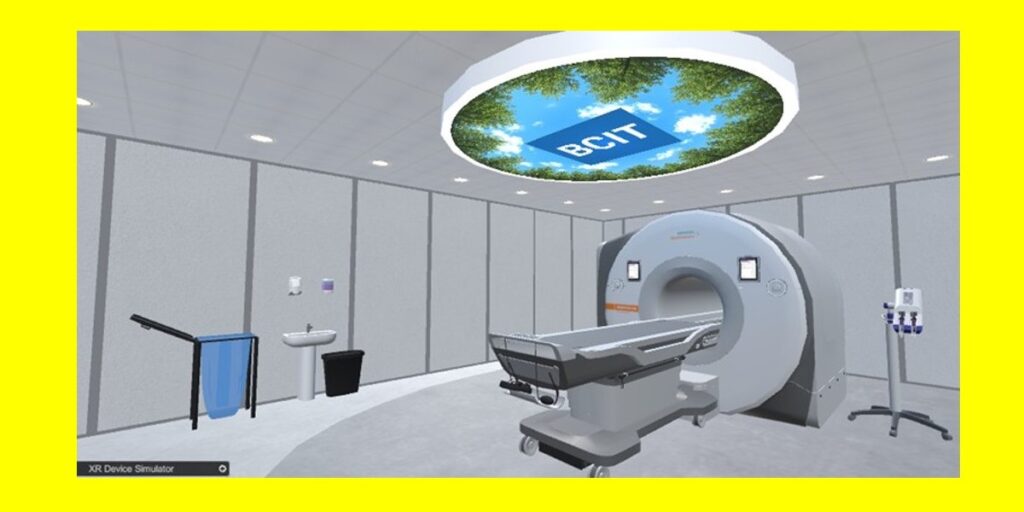
“This MRI project is a great example of how we can use tech to create something meaningful and useful for people” – Computer Systems Technology Diploma student Navjot Kehal
The cost and size of complex equipment can be a challenge in technical education, sometimes constraining the time that students have to hone their skills in a workplace-like setting before graduation.
Ray Lee, Program Head in BCIT’s Magnetic Resonance Imaging (MRI) programs, was looking for a simulator that could help his students get practice with the MRI exam procedure, without having to travel to a hospital at night, or wait for a time slot in the mock unit on campus.
He felt this problem might be suited to Virtual Reality (VR), yet there were no existing robust MRI VR projects.
“This kind of educational tool could be used by the MRI students for simulation and building that important muscle memory, not only to practice for lab exams, but to help prepare them for their clinical terms,” he explains.
Enter: Industry Sponsored Student Project
Ray brought his idea to Computing’s Industry Sponsored Student Projects (ISSP) Program, and it’s been a successful industry-student collaboration.
Along with BCIT’s School of Health Sciences Virtual Simulation Lead Lea Ducharme and Simulation Faculty Emily Tang, as well as Vienna Ly and Jason Yu from BCIT’s Learning and Teaching Centre (LTC), Ray has been working with ISSP teams over the last three terms on this inter-departmental project.
The students are in the Computer Systems Technology (CST) Diploma Program, where they normally work on two applied projects for industry clients after completing term three of the four-term program.
Learn more about Computing projects and ISSP
CST student VR MRI project takes shape

“The project has made significant progress over the last term,” according to Ray. “We are now at a point where we have the foundation laid out, and we’re ready to expand into multiple types of MRI exams. Most of the items within the VR environment are interactive, adding to the immersion of the user.”

“To be able to provide access to an MRI department – allowing users to flow through the different zones, interact with a patient, and go through the entire MRI exam workflow – without worrying about the dangers of the MRI magnetic field is great,” says Ray. “I think the students have worked hard to make it as realistic as possible.”
The most recent team is comprised of students Michael Doswell, Tom He, Navjot Kehal, and Bryan Le.
“It’s much cheaper than a mock MRI unit,” explains Navjot Kehal. “The prototype includes full simulated patient setup, from needed accessories to interaction with buttons, dials, and coils. It also offers real-time feedback about correctness of procedure.”
Adaptability and problem solving are key
“When we started this project, none of us had used the two main technologies involved – Unity and C#,” says Michael Doswell. “However, thanks to CST, we had experience learning new things quickly. We were also able to put our software design knowledge to work right away, even while the specific tools were unfamiliar to us.”
Tom He agrees that CST’s strong foundation in programming fundamentals was essential for tackling this project. “The skills I developed allowed me to adapt, learn quickly, and solve complex problems effectively,” says Tom, who was working as a pharmacist before he decided to apply to CST.
“There were a lot of things that did not work, but that did not stop us from achieving what we wanted,” says Navjot. “Because of all the challenges we went through in our other courses, we knew we had skills and determination.”
Navjot says he cannot stress enough the importance of clear communication in a project like this: asking good questions, and identifying what you know and don’t know. “Eventually, we were able to create an amazing VR MRI simulation that our client is very happy with.”
The project has gone so well that it was accepted for presentation at the IEEE/ACM conference on Connected Health: Applications, Systems and Engineering Technologies (CHASE), a leading international conference in the field of connected health.
Final thoughts on a hands-on program
The team members, who are all graduating this month, have also planned for a smooth handoff to future teams, with good documentation and access instructions.
“I found the project both challenging and incredibly rewarding,” reports Tom. He was originally drawn to software development because it was fun, interesting, and challenging, and chose CST for its hands-on, practical approach. “It was exciting to see how much progress we made over time, and even more fulfilling to know that our work has real-world applications and benefits for students.”
For Navjot, “this MRI project is a great example of how we can use tech to create something meaningful and useful for people. It is a portable training tool that any school can adopt and use, and it can benefit lots of other people. Being able to have the skills to do things like this is very empowering.”
Reflecting on the program, student Bryan Le says “CST has taught me many skills, from the soft skills needed to plan and work in a team, to the coding mindset required to break down the many problems and puzzles that I encountered working on a project like this.”
“The CST students have been nothing but professional and a pleasure to work with,” reports project sponsor Ray. “I got a lot out of this experience as well, learning how to implement VR best practices and helping them understand the world of Magnetic Resonance Imaging. I’m impressed and excited about where we’ve gotten.”
Looking forward, Michael says “it’s exciting to think of working on more and more complex problems over the course of a career in software development.”
Thanks also to the fall term students who worked on the first part of this project: Tarasios Williams, Jaina Jose, Bhavnoor Saroya, and Marvin Sio.
Subscribe to Tech-It-Out quarterly to keep up with the latest from BCIT Computing